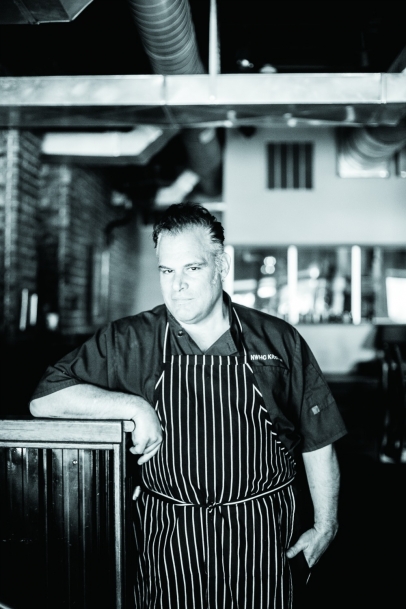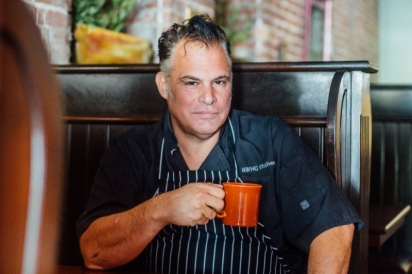Ric Orlando: Creating a Haven of Global Comfort Food
Walk into the New World Bistro Bar in Albany and you’ll see worn brick, crumbling plaster, steel girders and a stately Art Deco bar from the 1939 World’s Fair. These varied textures mirror chef Ric Orlando’s eclectic menu: Combinations that look unusual at first glance yet blend harmoniously. Jazz on a plate.
Ropa vieja, Cuban-style beef brisket braised in sofrito, olives and wine, served with plantains, yams, black beans and brown rice. Salmon with Thai seasonings alongside peanut slaw, braised greens, lemongrass-garlic vinaigrette. A hearty plate of rice, beans, market veggies and chimichurri-grilled tofu. Cocktails also reflect creative mixology.
Scott Meyer and Annette Nanes partnered with Orlando to open the New World Bistro Bar in 2009, the younger sibling to his New World Home Cooking in Saugerties.
Here’s a glimpse into this popular chef’s backstory.
Edible Capital District: Describe your path into the culinary world.
Ric Orlando: I grew up in a crazy mixed Italian family with a Latino stepfather and Sicilian relatives who farmed in Connecticut, so I was always around food with an ethnic connection. I flipped burgers and made pizzas to support my music habit. But my real culinary training began at Harvest Restaurant in Cambridge, Massachusetts, in 1980. It was a farm-to-table restaurant with a daily menu, way ahead of its time. Basically a food think tank. We’d brainstorm menu ideas and play with new ingredients. What the heck is jicama? This was pre Google. We had an amazing chefs’ library and stacks of Gourmet magazines, which we’d use for research.
In 1988, my wife and I moved from Boston back to Queens where Liz is from. Queens County is the most culturally diverse area in the country with about 140 languages spoken. Flushing and Astoria are the melting pot of food. I would walk around Queens and sample all the crazy good ethnic foods and that really inspired me.
ECD: Then you moved up to Albany?
RO: Yeah, it was cheaper to live here. I had a Mohawk and pierced ears and was told I wouldn’t get a job as a front-of-house manager looking like that. So I interviewed for a bartending position at a high- end restaurant called Yates Street. Turns out they needed someone to fill in for the chef who had been in a motorcycle accident. I had cooked but never been “the chef.” It was pretty intense and I learned on the fly, with my Larousse Gastronomique and Julia Child. I started throwing in little exotic touches like ... basil or cilantro. Back in the late ’80s, if you wanted fresh basil, you had to order it three days in advance! After work, I’d have a few beers over at Justin’s on Lark Street and ended up as chef there from 1990 to 1992. At the time, no one was stepping beyond continental French and Italian. So we redid the whole menu and brought in global cuisine.
ECD: And you helped bring farm-to-table to the Capital Region.
RO: I would drive around in my overheating Volvo and approach farmers to buy direct for the restaurant. Some were pretty suspicious of me. You want what? But then I started to develop relationships with a few of the smaller farmers, some who still grow for me. I would also drive down to New York and load up with things I couldn’t get in Albany at the time, like goat cheese, Thai green curry paste, plantains. Other chefs started asking me to hook them up, so I became like a dealer, selling out of the back door of the restaurant!
ECD: So that became the genesis of New World Home Cooking?
RO: It did. In 1991 we compiled an old-school printed catalog with spices, salsas, hot sauces, ethnic cooking ingredients I gathered. We had a tiny storefront in Tannersville, open on weekends. We’d pack the spices and sell them wholesale.
Two years later, we found a 1720s stone farmhouse in Woodstock, with wide warped plank floors and low ceilings. Stuff that’s cool now but wasn’t back then. Some friends helped fund the restaurant and we opened May 1993. We moved to a bigger place in Saugerties in 1998.
ECD: But you always kept a presence in Albany.
RO: That’s right. I’m involved in a lot of nonprofits. Each September I emcee the annual Chef and Vintner’s Harvest Dinner to raise funds for the Regional Food Bank. Mazzone donates the space at the Glen Sanders Mansion. We put together a team of seven or eight chefs and students and plan a harvest dinner, with 65% to 70% of the product sourced locally. I also help with the Lymphoma Society, Equinox, American Heart Association and the Center for Positive Health. Albany is the epicenter of nonprofit food events.
ECD: Tell me about your family.
RO: My wife, Liz Corrado, and I live in the Woodstock area. We’re true partners in this business. I’m in Albany at least three days a week, and she oversees the Saugerties operation. She’s a lawyer and has been in management her whole life. We’ve been married for 31 years and have three kids—Sidney, Willy and Terry. We’re a pretty tight family.
ECD: How do you and Liz unwind?
RO: We travel for food and drink. New York, Boston, Montreal, New Orleans. When we have free time, we go someplace where we can relax and participate in our industry from the other side. We enjoy stimulating food and creative cocktails, places with good energy.
ECD: How has the Albany culinary scene evolved in the last 20 years?
RO: Albany has become an excellent place to eat, beyond just the fine dining options it had been known for. We have an increasingly enthusiastic customer base that wants to be challenged and engaged. I meet a lot of culturally progressive, attuned people. Albany Medical Center and SUNY Polytech have brought such a global population to the area. I can have a table of 12 on a Saturday night and there may be 10 different nationalities in that one grouping.
ECD: Why so passionate about global cuisine?
RO: I gravitate to the melting pot concept. Living in Queens and Cambridge and growing up in New Haven gave me the chance to witness the enthusiasm immigrants have for the foods of their home country. They take such pride in sharing their cuisine with people who express an interest. “You must try this!” They want you to understand their food so you can better understand their culture. I can go to an anonymous little family restaurant, eat the meal and leave. Or I can let the staff know I’m also in the food business and suddenly the owner comes out and we begin to engage over food. Everybody wants to share. They’ll take me in the back, show me their ingredients and introduce me to new products. It’s pretty amazing.
ECD: Your ethos, bumper-sticker-style?
RO: Make it real, keep it simple. I firmly believe that when you do the authentic thing, you build a loyal customer base.
RAPID FIRE QUESTIONS
Edible Capital District: Breakfast today?
Ric Orlando: Coffee, an apple, and some leftover fingerling potatoes.
ECD: Favorite childhood meal?
RO: Mac and peas. My nonna would make elbow noodles with peas and butter and give me the grated cheese and black pepper.
ECD: Cake, pie or cookies?
RO: Cookies. Chocolaty, nutty, chippy cookies, crunchy not soft.
ECD: Guilty pleasure?
RO: A big Italian cold-cut sandwich.
ECD: Midnight snack?
RO: Ice cream or gelato.






